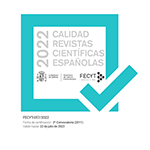Lights and shadows in the application of the resazurin test on Macaronesian flora
Abstract
Seed viability tests are essential for seed bank management and the ex situ conservation of genetic biodiversity. Although there are different methods for determining the viability of the seeds, none of them is 100% effective, many require a considerable number of resources, some are not entirely reliable, others are time-consuming, they destroy the seeds, and/or can even be dangerous for the researcher/laboratory technician. However, a new simple, quick and non-destructive seed viability test has been recently described. This method is based on the reduction of resazurin to highly fluorescent resorufin by the respiration of a yeast activated by solute leak from non-viable seeds. In the present study, we tested this method in 53 taxa from 28 families from the Macaronesian region. We did not find a significant correlation between the germination and the resazurin test. Although there were several taxa that showed a high positive correlation, many other taxa exhibited a low positive correlation. Besides, we did not detect standard absorbance values from the resazurin test that determined seed health conditions. Though the resazurin viability method could be a good viability test, this should be standardized for each taxon.
Downloads
Article download
License
Mediterranean Botany is an open access journal to promote global exchange knowledge. It facilitates unrestricted access to its contents from the moment of publication in its electronic edition. The originals published are property of the Universidad Complutense and it is mandatory to cite such source in case of total or partial reproduction. All contents are distributed under a Creative Commons License 4.0 (CC BY 4.0). This circumstance must be expressly stated in this way when necessary. You can check the informative version and legal text of the license.














